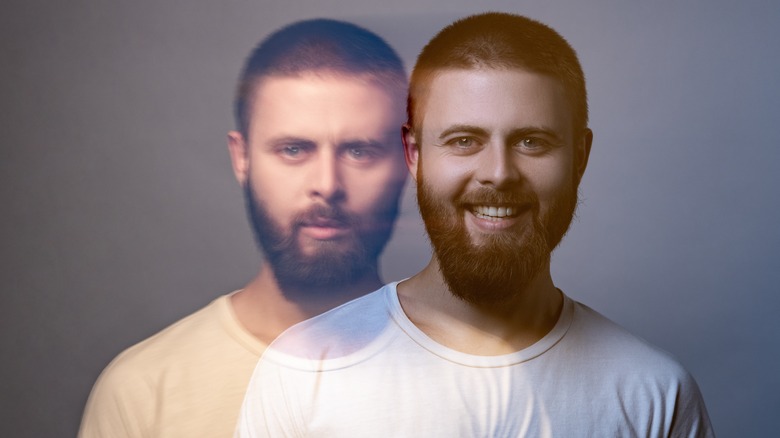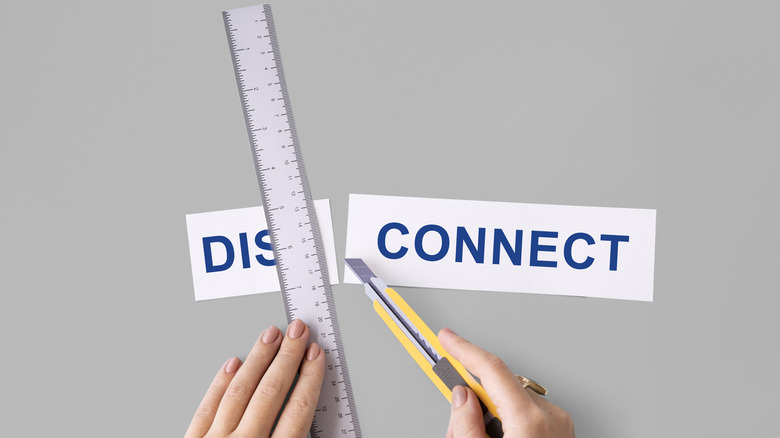Most of us probably don’t think too much about how we’re connected to ourselves, the people around us, and the world in general. In fact, it’s likely something many take for granted. But those who deal with disassociation know just how daunting it can be when it suddenly feels like you’re not connected to anything at all — not even yourself. It’s a mental limbo that can be incredibly scary.
This sense of disconnect is often a sign that someone is suffering from a disassociation disorder. According to the Cleveland Clinic, roughly 2% of Americans suffer from dissociative disorders, and even though it can affect literally anyone, more women are diagnosed with it than men. According to the National Alliance of Mental Illness, around 75% of people experience some form of disassociation at least once during their lifetime.
Unfortunately, as with many mental illnesses, disassociation is frequently misunderstood and misdiagnosed. According to a 2024 study published in Dialogues in Clinical Neuroscience, there are professionals in the field of psychology who have beliefs about this disorder that simply aren’t backed by science. Some argue that the disorder is solely a result of the side effects of some medications or is caused by some other socio-cultural factors. No research supports these theories, and the study urges that more awareness be created around this disorder and that additional research be conducted to improve diagnosis and treatment. Read on for everything we do know about disassociation, how it’s diagnosed, and how to treat it successfully.
Disassociation explained

As the name suggests, disassociation is a mental health disorder characterized by feelings of disconnect. It usually manifests as feeling disconnected from your body, your thoughts, and even the space you find yourself in, clinical psychologist Sabrina Romanoff, told Forbes.
“A person might subjectively experience dissociation as floating outside the body, feeling numb to your emotions or feeling that things are not right and reality feels unreal somehow,” Noël Hunter, clinical psychologist, explains to Forbes.
According to Medical News Today, some experience an almost out-of-body sensation when they’re having a dissociation episode. They are aware of reality and they know that they’re having a strange experience, but they’re often powerless to stop it. Some people even assume other identities while they’re having an episode. As for what physically happens to your body, Colette Lord, PhD, trauma therapist, told Well+Good that the body releases certain chemicals to induce disassociation. “The body releases its own opioids and cannabinoids, which reduce perceptions of physical and emotional pain and produce calm and a sense of detachment from what is happening,” she explained. Activity in most parts of your brain also decreases, while other areas like the temporal lobes and limbic system, which are responsible for basic functions like hearing and speech as well as memory and emotion, go into overdrive, explains psychiatrist Daniel Amen.
If you or someone you know needs help with mental health, please contact the Crisis Text Line by texting HOME to 741741, call the National Alliance on Mental Illness helpline at 1-800-950-NAMI (6264), or visit the National Institute of Mental Health website.
Disassociation can feel different for everyone

While most people with disassociation will experience similar symptoms, their actual experiences will differ since we’re all unique. For example, some might be aware of what’s going on around them while they’re experiencing disassociation, while others will zone out completely with no awareness of their surroundings, trauma therapist Colette Lord, PhD, told Well+Good.
“As people have different brain patterns, their symptoms can vary from periods of spaciness, to panic, to rage outbursts,” explains psychiatrist Daniel Amen.
People who suffer from post-traumatic stress syndrome (PTSD) and disassociation sometimes experience flashbacks of the upsetting event while they’re having an episode, Gail Saltz, MD, says, adding, “Those intrusive flashbacks are like a daydream you can’t stop having, and you’re unaware of what’s going on now.” Dr. Lord says that others experience a change in their identity. “For some who were abused as kids, they might get triggered and experience themselves as a small child in how they are reacting and feeling,” she says, adding that the person is usually fully aware that they are not a child, but they experience childlike emotions.
Dissociative episodes can be triggered by various things, from traumatic memories to low blood sugar, stress, and lack of sleep, Amen explains. Saltz adds that some people’s triggers are harder to pinpoint, however, and in some cases, they can’t identify them at all, which makes treatment more challenging.
It is commonly related to trauma

Semachkovsky/Shutterstock
Sometimes, people experience disassociation while going through something traumatic, and in some cases, disassociation returns even after the event has passed. “For those who have developed PTSD and related disorders, their brain remains on high alert for potential danger,” trauma therapist Colette Lord, PhD, explains to Well+Good. Post-traumatic stress disorder can cause the brain to overreact to even the most trivial things, like situations that are emotional or even slightly threatening. Your brain recognizes it as a life-or-death situation and induces disassociation to protect the body.
Clinical psychologist Noël Hunter told Forbes that the body has various responses when presented with danger. These include the fight or flight response as well as the freeze response. Disassociation is the latter, and it’s a defense mechanism to avoid dealing with an overwhelming situation. “You feel you cannot move or think straight. The brain goes offline, except for certain parts that are necessary for life, like breathing,” she explains.
Dr. Hunter explains that those who experienced abuse or trauma as a child often go into this state of disassociation when experiencing similar situations in their adult life. This is simply their brain’s way to protect them from reliving painful memories. Dr. Hunter adds that people can stay in this state for a while, depending on the severity of the event the brain is trying to dissociate from.
Some medications and other mental disorders might cause symptoms of disassociation

fizkes/Shutterstock
While trauma often plays a big role in disassociation, other factors can also put people at risk of experiencing it. The most common culprits are recreational drugs. According to Medical News Today, these substances mess with the chemicals in your brain, which can then trigger disassociation. Alcohol and hallucinogens can have this effect on some people, while ketamine, which is utilized to treat depression, can cause disassociation as one of its side effects, according to a 2024 study published in Nature Communications. A 2024 study published in The American Journal of Psychiatry found that sometimes, people who use or try to quit cannabis experience disassociation as a result.
If you already suffer from other mental health conditions like depression, post-traumatic stress disorder, obsessive-compulsive disorder, phobic disorder, or schizophrenia, you might be at a higher risk of developing disassociation. Those who have epilepsy and get migraines are also more susceptible to this disorder.
People can suffer from dissociative amnesia

fizkes/Shutterstock
As the name suggests, dissociative amnesia refers to a type of disassociation where the person experiences certain gaps in their memory. People with dissociative amnesia typically find that they can’t remember things that happened in the past, and sometimes, they even forget crucial information about themselves, according to the NHS. In some cases, this disorder also causes people to forget how to do certain things they were once good at, leading to the loss of some skills and talents. It’s important to understand that dissociative amnesia isn’t just a bad case of forgetfulness — people with this condition experience significant gaps in their memory, and it sometimes leads to precarious situations where they wander around confusedly with no idea how they got to where they are.
According to the American Psychiatric Association, the memory loss that accompanies dissociative amnesia can manifest in three ways: Localized memory loss (when you can’t remember a period of time or a past event), selective memory loss (when there are certain things about events or time periods you can’t recall), and generalized memory loss (when you can’t remember anything about who you are or your past life; this is very rare).
Those who were emotionally neglected or abused during their childhood are more prone to suffering from this disorder. Depending on the severity of the disassociation, someone can have these episodes for a few minutes, hours, or even days. In severe cases, this “blanked out” state can last for months or even years.
Dissociative identity disorder is another form of disassociation

alexkoral/Shutterstock
Formerly called multiple personality disorder, dissociative identity disorder refers to people who experience having more than one identity. According to the NHS, people with this disorder are typically aware that they have other identities, which leads to confusion about who they really are. These other identities all have their own history, names, and characteristics, and the person’s behavior will change accordingly as these different identities take over. Other symptoms that are indicative of this disorder are experiencing memory loss about past traumatic events or forgetting personal information and daily happenings, according to the American Psychiatric Association.
People with dissociative identity disorder have no control over their other identities, and sometimes, they experience the sensation of watching themselves from afar as they become someone else. They may also experience a change in how their body feels: Some feel like a child, while others experience the feeling of inhabiting the body of a different gender. Just like dissociative amnesia, this disorder is usually the result of stressful or traumatic experiences people dealt with as a child, like physical or sexual abuse.
Derealization or depersonalization is also a form of disassociation

BeautyStars/Shutterstock
This dissociation disorder refers to two separate conditions that usually go hand in hand, namely derealization and depersonalization. When someone experiences derealization, they feel entirely disconnected from the space they find themselves in with the eerie sense that the people and environment around them aren’t real, according to the American Psychiatric Association. Depersonalization, on the other hand, refers to a condition where people feel disconnected from themselves, which manifests as a feeling of disconnecting from the body or the mind. This typically feels like an out-of-body experience, where people see themselves from a distance and watch as things happen to them instead of actually experiencing them. Some people have only one of these disorders, but they can also have both (per the NHS).
This disorder is particularly stressful because, even though someone feels like they are disconnected from their body or the environment or both, they are well aware of what’s happening and that what they are experiencing isn’t normal. These episodes usually don’t last very long, and the person will only experience the disassociation for a few minutes. Symptoms of these disorders typically start showing up during childhood, with 16 being the average age at which they are first observed. Few people start experiencing these disorders above the age of 20.
Various symptoms can indicate a disassociation disorder

My Ocean Production/Shutterstock
While people all experience disassociation in different ways, there are some common symptoms that can indicate that someone might have the disorder. According to the National Alliance on Mental Illness, common signs and symptoms include being unsure of your identity and experiencing noticeable memory loss usually related to events, people, or specific time frames. Out-of-body experiences are usually another sign of the disorder, along with the feeling that you’re disconnected from your own emotions. Some people even experience a complete lack of emotion.
Experiencing other mental health problems alongside these symptoms, like anxiety, depression, and suicidal thoughts are also indicative of disassociation disorders. Of course, symptoms will differ depending on the type of disassociation disorder someone has.
A 2024 study published in Advances in Psychiatric Treatment concluded that other symptoms can include experiencing a change in your body’s senses or being unable to react emotionally to whatever happens to you or around you. People with disassociation can also experience anxiety because of the disorder, or have the disorder as a result of anxiety.
Diagnosis

SB Arts Media/Shutterstock
Getting diagnosed with a disassociation disorder can be a tedious process, especially because it typically has symptoms associated with other physical diseases that need to be ruled out first.
To start, your doctor will usually ask you about your life and medical history. Then, you’ll have to undergo tests to eliminate physical issues like sleep problems, head injuries, and brain tumors. Usually, doctors will also include tests that will pick up alcohol or drug use, according to the Cleveland Clinic. Your doctor might also order other neurological tests to rule out conditions like epilepsy, per Medical News Today. If all your tests come back clear, your doctor will start to assess whether you might have a mental health disorder, taking all of your symptoms into account. They will refer you to a mental health specialist to assess you further if they suspect you might be suffering from a disassociation disorder. The psychologist or psychiatrist will typically encourage you to open up about past events that have been traumatizing or disturbing in order to correctly diagnose you (via WebMD).
Treatment of disassociation disorders

Ilona Kozhevnikova/Shutterstock
Various types of therapy exist to help treat disassociation disorders. Speaking to Forbes, clinical psychologist Sabrina Romanoff explained that, while some people with disassociation don’t need therapy because they rarely experience it, those who find that it completely disrupts their day-to-day life need to get treatment.
Dr. Romanoff explains that there are three types of therapy commonly used to treat people with disassociation disorder: psychotherapy, cognitive behavioral therapy (CBT), and dialectical behavioral therapy. It’s important to note that these therapies might not cure your disassociation, but they can help you to manage your symptoms effectively when you apply the tools they provide you with.
You might need to try different therapies to find what works for you, clinical psychologist Noël Hunter explains, and that’s why different options are available. “Ultimately, the goal is to help incorporate the different aspects of [an individual’s] identity and experience that get fragmented or dissociated to protect them from the trauma,” Dr. Romanoff explains, adding that most people’s goal when they start therapy is to learn how to effectively take control when they experience an episode.
Signs that indicate you need to see a doctor

Maridav/Shutterstock
According to Medical News Today, it’s pretty common for people to sometimes experience symptoms of disassociation, like feeling detached from themselves or their surroundings. If these episodes only occur every once in a while, you likely have nothing to worry about (however, it’s always a good idea to mention it to your doctor). Constantly experiencing disassociation symptoms that are pretty intense or last for long periods of time is definitely a cause for concern, especially if they start to impact your day-to-day activities.
“If once in a blue moon you’ve experienced walking down the sidewalk and not really knowing how you got to where you are, it’s not really affecting your life,” Noël Hunter, clinical psychologist, told Forbes, adding, “But if it’s happening every day and you’re finding yourself in strange places not knowing how you got there, now we’re talking about something that’s pretty severe, dysfunctional and much more qualifying as a disorder.” It’s crucial you make an appointment with your doctor or psychiatrist in these cases so they can help you manage your symptoms.
Experiencing flashbacks of traumatic experiences, engaging in risky behavior while in a dissociative state, or having suicidal thoughts are dangerous, and usually warrant a trip to the emergency room for immediate treatment (via the Mayo Clinic).
Not treating disassociation can make it worse

Rawpixel.com/Shutterstock
Just like you can’t cure a broken leg by ignoring it, the ongoing impact disassociation can have on your life won’t go away without treatment. In fact, according to clinical psychologist, Noël Hunter, your disassociation might become worse the longer you choose to ignore it and forfeit treatment.
“Basically, what that does is reinforce [dissociation] as a coping mechanism,” Gail Saltz, M.D. told Well+Good, adding that you have a better shot at overcoming this disorder if you seek help from a therapist who can help you to become “immune” to your triggers.
A disassociation disorder that goes untreated will slowly start to impact every facet of your life, Dr. Hunter told Forbes. You might gradually start to lose your sense of self and identity, experience gaps in memory, and even find it difficult to stay focused on the present. Some people with untreated disassociation also can’t maintain relationships and constantly feel unsafe. As if all these symptoms aren’t scary enough, disassociation can also put you in the path of physical danger if you’re often unaware of your surroundings, which means something as simple as crossing the street might turn into a life-threatening situation when you don’t realize you need to look out for oncoming traffic.
Things you can do to help you deal with disassociation

fizkes/Shutterstock
The most important thing you need to do when you realize that you’re dissociating is to seek help from your doctor or a qualified therapist. “From a prevention perspective, getting into good therapy to address and work through the trauma is often essential,” trauma therapist Colette Lord, PhD, told Well+Good. She added that dealing with the root of the problem often leads to experiencing fewer disassociation episodes, and sometimes, they disappear altogether.
Your therapist will also provide you with the necessary tools to bring yourself back to your body when a disassociation episode strikes. “Taking advantage of every sense you have and rooting your mind in something very concrete can be helpful,” Dr. Gail Saltz says. You’ll learn a variety of grounding techniques to help you manage your episodes. Saltz recommends tactics like smelling peppermint oil, refocusing your attention by holding onto something cold like an ice cube, or even engaging your brain by counting back from 100. Other useful tools include listening to upbeat music or doing activities that require you to connect with your body, like singing or dancing.
This is how you can help someone with disassociation

Prostock-studio/Shutterstock
If someone close to you has been diagnosed with disassociation, it can be hard to know how to help them, but luckily you don’t have to be an expert to be there for them when they need you.
The most important thing you can do, according to Dr. Gail Saltz is to support them during an episode. “Just sit with them and focus on supportive statements, like ‘I’m here with you,’ ‘It’s going to be okay,’ or ‘I’m going to help you,” Dr. Saltz told Well+Good. You can even familiarize yourself with the grounding techniques they were taught in therapy so you can guide them through it while they’re having an episode. What you should never do is react aggressively, Dr. Saltz adds. This should go without saying. Reacting in an aggressive way will likely only increase the person’s anxiety and, in turn, make the disassociation episode even worse.




